In the hours before he learned his airplane had won an award, Adrian Eichhorn sat wearing a breezy and elegant Hawaiian shirt, settled barefoot in a camping chair in front of his highly modified 1962 Beech P35 Bonanza at EAA AirVenture in Oshkosh, Wisconsin. His relaxed confidence and warmth immediately evident despite the noise of the airshow overhead and the fact that he’d been sitting and waiting patiently for judges to arrive unannounced for most of a week.
He would eventually learn that this award was none other than the coveted Reserve Grand Champion Customized Silver Lindy, the highest eligible award for a customized aircraft.
EAA AirVenture Oshkosh is the biggest airshow in the world. In 2018, there were approximately 601,000 visitors, 10,000 aircraft overall, and 2,979 show planes on the grounds. Hundreds of aircraft are entered into the competition for the highly sought-after Lindy Awards. But only the best of the best can win.
According to EAA, “The Lindy is recognized worldwide as the ultimate recognition of aircraft craftsmanship. Lindy Award judging takes into account how an aircraft looks, of course, but the degree of craftsmanship involved plays an important role as well. Award-winning aircraft don’t just look pretty, they are carefully built, restored, and/or maintained by owners who take great pride in them.”
This is what Adrian had achieved through almost 30 years of diligent and detailed work beyond possibility for most of us.
So the Lightspeed team was honored when Adrian agreed to share his story of what led him and his airplane to be named “the best of the best.”
Sitting in the cool and relative quiet of the small Florida Air Museum on the grounds at SUN ‘n FUN this past April, Adrian walked us down his path to the Lindy.
A V-tail Bonanza
“My journey started long before I bought the airplane. I went into the army hoping to be a pilot but was put into the Army Corp of Engineers because of my degree in civil engineering. After spending four years trying to get into flight school in the Army, I finally realized I would have to do it on my own. So I started taking lessons and got my ratings on my own.” Though he’d always wanted to be a pilot, he was 29 when he finally soloed.
When he transferred back to the east coast for his work in 1989, he began looking for an airplane.
“A friend of mine… My god, here is right here!” Adrian’s friend, Ron Timmermans, walks up at the moment he starts to tell the story—proof that Adrian truly knows everyone. “This is the guy I took my first flight in a Bonanza V-tail with!” He turns back to his friend. “We are doing a little interview and I was just talking about what led up to the purchase of my Bonanza!” The old friends chat and joke for a moment. When they say their goodbyes, Adrian starts right back into the story without missing a beat, unfazed that the very person he was discussing from 30 years before happened to walk up the moment he was mentioned.
“So, I went down to Texas, flew in his V-tail and got hooked. I was staying at his house and started looking through a Bonanza magazine. I started reading it and realize, these are really cool airplanes. You can do all kinds of modifications. That led to buying my V-tail.
“I didn’t know anything about Bonanzas then, or aircraft ownership. I didn’t know anything about a proper pre-buy. And the plane…. it was nice. It was all I could afford at the time. $35,000. My dad loaned me $5,000 for the down payment and I financed $30,000. But it had issues, which I didn’t really learn about until later.”

A “before” picture of the Bonanza

The cockpit before work began
“If you look at pictures of what the airplane looked like when I bought it, it’s pretty ugly. But I was proud to own it back then. And, I thought, this is an airplane that I will probably have over a long period of time.”
Need a good aviation mechanic? Become one
In 1990, Adrian brought the Bonanza back to Virginia. “I made good friends with a couple of A&Ps in the area. And I started getting involved in restoring the airplane. From the day I got (the airplane) home, I was tinkering with it.”
He replaced the interior, installed a new panel and rebuilt the engine.
“This led to me getting my A&P (mechanic certificate). I used all that time under the supervision of other mechanics to get my practical experience to become a (licensed) A & P. Then I got my IA (inspection authorization).
“I specialized in knowing a lot about Bonanzas. And to this day that’s all I work on.
“I respect the people that have deep pockets and can pay someone to restore their airplane for them. But I respect the person who does the work themselves even more.”
As for the Bonanza? “I didn’t pay anybody other than to paint the airplane.”
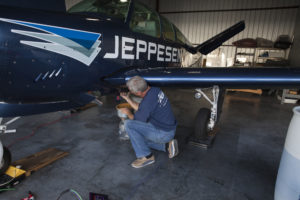
Adrian at work in the Cave
A side project in safety
In what appears to be Adrian’s style, he didn’t stop there. Through his attention to detail on his own plane, he developed a brand new way of using medical and dental equipment for boroscoping aircraft engines. From there, with grant money from the Air Safety institute and AOPA, he developed a poster that was shared with aviation mechanics for free nationwide.
It’s titled, Anatomy of a Valve Failure, and it teaches mechanics and owners what they are looking for inside the engine when they use a camera.
“I think,” Adrian adds modestly, “that’s what led to being selected as the FAA National Aviation Technician of the Year in 2016.”
We have to say, he’s probably right.
A Greenland adventure
It’s also part of what led to a General Aviation trip over Greenland in 2011.
“We had three Bonanzas and there were seven of us. I basically talked two of my friends into it. I said, lets go on an epic trip. Let’s stay in some marginal hotels, buy the most expensive gas on the planet but see the most beautiful scenery in the world.
“I’d flown over Greenland in corporate jets at 40,000 feet, but I wanted to see (it) from 500 feet.
“The two other Bonanzas that went with us, I had boroscoped their engines. I think that helped them feel more confident, because flying over the north Atlantic itself is a little risky that far north. All three Bonanzas flew flawlessly.”
Another long distance flight
“So when I got back from that trip, I thought, there is another long distance flight in my future. And I thought, you know this airplane’s in pretty good shape, but it can be better.”
That next trip became a flight around the world in 2016. Adrian spent four more years further restoring the plane in preparation.
“I pulled the wings off the Bonanza and completely rebuilt everything in the wings, the fuel tanks, the lines, electrical wires, everything.

Wings off!
“I basically cut the airplane in half and put in a large baggage door. And made the inside of the airplane as light as possible, because the lighter the airplane would weigh legally—you take out the backseats, the carpeting, the side walls—the more gas I could put in it to stay below it’s max gross weight. I pulled the engine out. Basically I replaced anything on it that I thought was worn. And all my friends helped me with this.”
A plane of a different color
After years of work to get every detail perfect, it was time to paint the plane.
“I had stripped it. There wasn’t a gram of paint on it. I did all the stripping myself. And I knew I wanted it to be different. I wasn’t going to paint it white. Every Bonanza out there is white with stripes or waves from front to back. But when I went to pick it up from the paint shop, I was sick to my stomach. It was the wrong color.”
The paint job was way over budget (more than two times the estimate) and the paint was the wrong color.
At first, “it was a low point of owning the airplane. But then I started putting the logos on it and now I love the color.” He adds, smiling, “it’s a great billboard!”
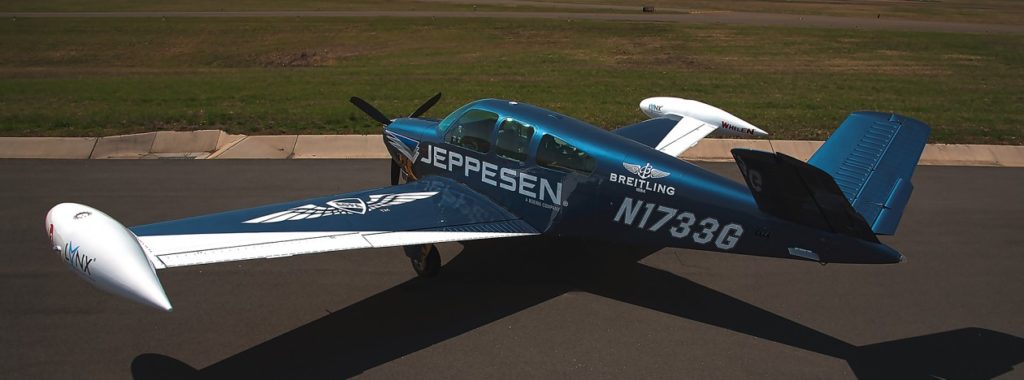
It’s a great billboard!
Once he got the plane back from the paint shop, he added one of it’s most unique features. “I put those big tip tanks on it which were old military drop tanks that were sized and built specifically to attach to this airplane. And it’s the only P-model Bonanza in the world that has those tanks. So the airplane now can go un-refueled for 26 hours.”
That was right before the trip in January of 2016.
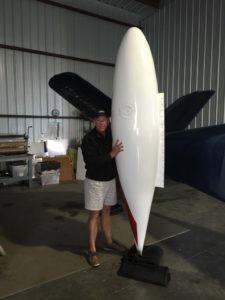
Tip tanks at the ready

Flying over the Greek islands
Around the world in 163-hours (of flight)
In April of 2016, Adrian started his 23,014 nm trip. And the thousands of hours of work he had invested over a quarter of a century in his V-tail helped him fly safely across the world.
“Short of an autopilot failure and one other little fuel line (issue) on the very first leg, it ran perfectly the whole trip.”
If you’d like to know more about Adrian’s trip around the world, check his website, Fly Blue Horizons or this story published by AOPA.
It was a father-son thing
“While my dad was still alive, every year we went to Oshkosh. My first year was 1989. Dad’s first year with me was 1990. It was hard once he passed away.”
They would consult together annually on the Bonanza project at AirVenture. They would plan a purchase or talk about what they had to do to rebuild the engine.
“It was a father-son thing the whole way.
“The airplane started as a project and I just got more and more into it. I thank my dad for this. If Dad was working on the lawnmower, he made me watch. If he was changing the oil in the car, he made me watch. So I’ve been a tinkerer. And with a degree in civil engineering, I’ve always been mechanically and design oriented. What drives me now is to take a piece of sheet metal or carbon fiber and make something completely different and hopefully better than the way the factory did it back then.”
It was those habits, taught by his father, which drove Adrian to work hour-after-hour to perfect his Bonanza and bring home the Silver Lindy.
The Cave
His hangar (“I call it the Cave”) at the Manassas Regional Airport in Virginia, is where he escapes to work.
“That is my Zen now. I’ll go out to the hangar and I’ll work 10 hours on some little project. And at the end of the day, if I don’t like it, I’ll throw it out and I’ll go home and start over the next day.”
But he’s so well known at the airport that sometimes he has to park behind the hangar and work with the door closed just to get through a project. Other times he loves to share.
“It’s become quite a well known place on the airport. Everybody wants to come over and see what’s going on.
“Flying for a living…I love it. It’s stressful at times. I look so forward to getting home and going out there and doing something on the Bonanza. It will never be finished.“
He’s already started on the next phase.
“I’m working with Dynon (Avionics) to install an all new three-screen panel that no one else has done. Then installing a more powerful engine is the next big thing.
“This little brain up here is always thinking of pushing the bar. And that was really the driving force behind the around the world trip, to do something I’d never done, to push the limits of flight planning, endurance, and all that. I just wanted to push the limits of what’s possible.”
2018: The Silver Lindy
The year that Adrian won the Silver Lindy, 2018, was the first and only year he entered the plane for competition at at Oshkosh.
“I kind of sat back on the sidelines and watched and looked at other airplanes that had won.” He decided not to enter until he was ready. Instead, he decided to wait for the shock effect.
“I know what is quality workmanship, quality design.” He decided not to enter until he had a pretty good chance of winning.
And here we circle back to Adrian at Oshkosh, parked in a camp chair in front of the Bonanza in 2018. He may have looked relaxed, but he was far from it.
“You have five to seven judges that, during the course of the week, come by. You don’t know when. So you pretty much have to stay with your airplane, because they wouldn’t know what work you’d done.” You have to be there to explain it he says—especially in the modified category. “You kind of have to sell your product to the judges.
“Half way through the week, I got a little worried, because judges would come up and I’d watch them judge other airplanes, and they’d have a piece of paper. But when they came up (to my airplane), no one had a piece of paper. And I thought this airplane must not even be in the running.”
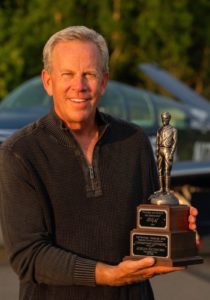
Adrian in front of his plane with the Silver Lindy in hand
There are many many airplanes in the contemporary division at Oshkosh, so Adrian had no idea what planes he was competing against or how many there were.
“The judges are coming by and they’re not writing anything down. I’m thinking this is a waste of time. Come to find out the ones that won, they didn’t need to write anything down. They already knew.”
“I love Oshkosh, but man I was exhausted when I left. (Everyday), you get there before all the people. You clean the plane off and get everything on display so it’s perfect when (the judges) come by. That got a little bit tiring.”
The coveted award
“On Thursday, I think, they come by and they give you a ribbon with a little tag that says, “This airplane won an award.” And they put it on the prop. But you don’t know what it is. They just say come to the award ceremony tomorrow night. So everybody goes.”
With the Lindys called last, Adrian waited anxiously through almost the entire ceremony before finding out his beloved 1962 Beech P35 was the Reserve Grand Champion in the Customized category.
“The whole thing was really a cool experience. But it’s a lot of work. You have to have the documentation of the restoration. And I had to show them what I modified.
I think they were impressed that I did all the work myself.”
A winner for life!
But what happens after you win? What now?
“You can take the airplane back (to Oshkosh) and park it in a certain area where the previous grand champions are. You’re up on the flight line. Pretty cool to have your own parking!”
Adrian plans to go back to AirVenture for three or four days this year. If you are lucky enough to find him there, you’re in for a treat. And since he has his own parking, you’ll know where to look.
“I think I’m most proud of the fact that mechanically, I built this airplane.
“My dad told me, “If you work on something or if you are going to be good at something. Be the best at something or get out of it.””
Adrian continues to strive to be the best. We know he’ll never stop tinkering. And we hear there may be another adventure in the works for 2020. Stay tuned.”

All photos in this story are the property of Adrian Eichhorn and are used with his permission.



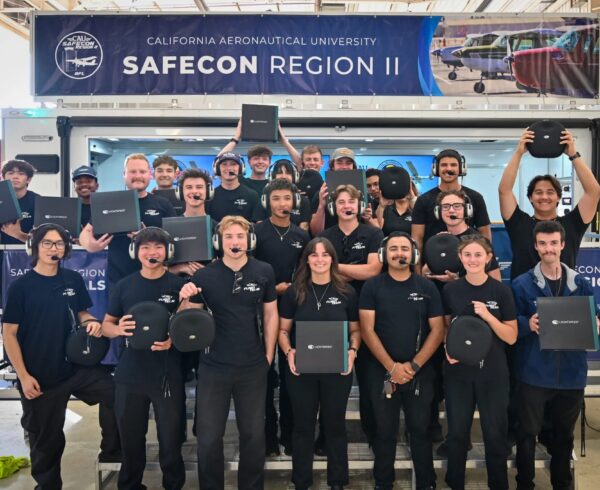

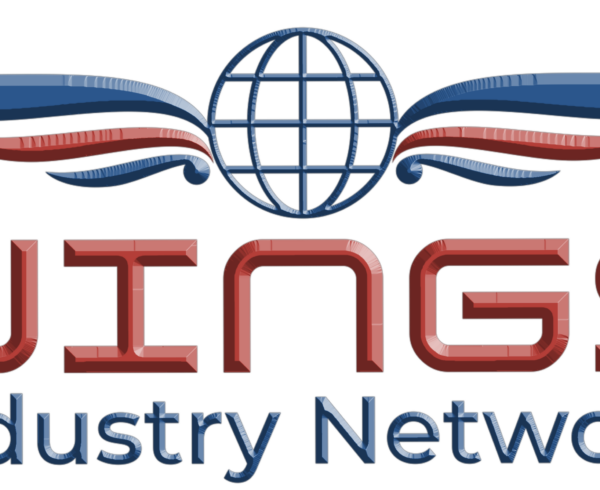








Very informative post.Much thanks again. Fantastic.
Great blog post. Really looking forward to read more. Awesome.
This is a fabulous article and so well written. I am a novice with airplanes yet I learned a lot from Adrian’s advice. What I liked the most is I felt like I was right there hanging out with the man.
What a great article! Awesome research and photos.